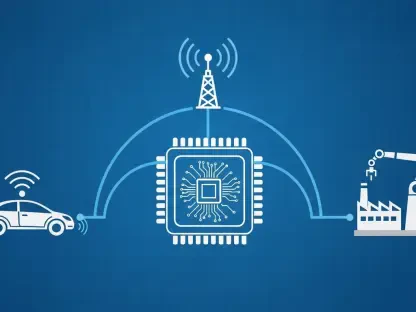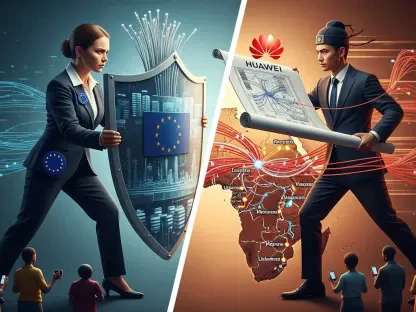The smart eyewear industry is witnessing a profound transformation due to technological advancements in the Internet of Things (IoT) and artificial intelligence (AI). This evolution is reflected in the significant market growth, with forecasts indicating an impressive rise from $878.8 million in 2024 to $4.12 billion by 2030. Such acceleration is being driven by the increased adoption of smart glasses across various sectors, including manufacturing, healthcare, warehousing, and construction. At the heart of this growth are diverse applications ranging from remote assistance and employee training to hands-free task execution and enhanced worker safety. As IoT and AI continue to innovate, the capabilities of smart glasses are expanding, offering a plethora of benefits for personal and professional use.
Adoption Across Industries
The integration of smart glasses into various industries is becoming increasingly common, bringing in numerous advantages and reshaping how tasks are performed. In manufacturing, these advanced devices provide workers with real-time data, streamline processes, and support hands-free operation, thereby minimizing errors and enhancing productivity. Healthcare professionals utilize smart glasses for remote consultations, real-time access to patient data during surgeries, and even training purposes. Similarly, in warehousing, smart eyewear aids in inventory management, improving accuracy and efficiency. Construction workers benefit from augmented reality capabilities for on-site evaluations, reducing risks and improving safety standards. The versatility and utility of smart glasses are evident, making them indispensable tools across these sectors.
Furthermore, the real-time information and remote assistance provided by smart glasses are crucial for improving employee training. Workers can receive guidance and instructions without interrupting their workflow, thus accelerating the learning process. The hands-free nature of smart eyewear enables professionals to perform tasks more effectively while maintaining access to essential data. Enhanced safety is another significant advantage, as workers can stay informed without the need for physical documentation, reducing the likelihood of accidents and injuries. In sum, the adoption of smart glasses across these industries not only boosts operational efficiency but also contributes to a safer working environment, underscoring their transformative potential.
Technological Advancements
The continuous improvements in technology are crucial for propelling the capabilities of smart glasses to new heights, with augmented reality (AR), advanced displays, and sensors playing pivotal roles. AR technology is particularly transformative, overlaying digital information onto the real world, thereby enhancing the user’s interaction with their environment. Advanced sensors integrated into smart glasses provide real-time data, such as environmental conditions and biometric information, enriching the user experience. Sophisticated displays ensure clear visibility of crucial information, making tasks easier to manage and execute. Such technological advancements are making smart glasses more adaptable and efficient in various scenarios, from industrial applications to everyday personal use.
Moreover, the development of 5G technology and widespread high-speed internet connectivity are significant drivers of innovation in the smart eyewear market. The enhanced connectivity enables instant data transmission and seamless integration with other devices, further expanding the horizons of smart glasses functionality. With 5G technology, real-time collaboration and communication become more effective, enabling professionals to work more efficiently. High-speed internet boosts the performance of AI-powered features in smart eyewear, leading to improved accuracy and responsiveness. The convergence of these technologies is energizing the smart eyewear industry, making it possible for users to access information and perform tasks at unprecedented levels of efficiency and convenience.
Impact of IoT
The IoT revolution plays a crucial role in the proliferation of smart homes and wearable technologies, showcasing how interconnected devices can significantly enhance efficiency, safety, and cost-effectiveness. Incorporating smart glasses into IoT systems marks another evolutionary step, where devices interact seamlessly to deliver improved user experiences. For instance, smart glasses integrated with machine learning algorithms and sensors can assist individuals with disabilities in navigating their environments. These advanced systems can offer real-time guidance, enhancing mobility and independence for users. IoT also enables smart glasses to connect with other devices in an ecosystem, facilitating remote monitoring and control of various functions, adding layers of convenience and safety.
Furthermore, IoT integration is fostering new opportunities for smart glasses in different applications, such as smart home management and workplace optimization. In smart homes, smart eyewear can control devices, monitor security systems, and manage energy usage, creating a highly efficient living environment. In workplaces, integrating smart glasses with IoT allows for advanced data collection and analysis, optimizing operations and improving productivity. IoT technology also enhances preventive maintenance algorithms, helping industries predict issues before they occur and reducing downtime. The impact of IoT on smart eyewear is extensive, driving innovations that align with the growing demand for interconnected and efficient systems.
AI Integration
Artificial intelligence is revolutionizing smart eyewear by embedding advanced functionalities that cater to diverse user needs. The rise of generative text and voice AI is particularly noteworthy, enabling smart glasses to perform complex tasks with ease. Modern smart eyewear comes equipped with AI-powered assistants capable of taking photos, recording videos, providing navigation assistance, translating text, and offering real-time information. These AI systems are designed to be intuitive, providing users with seamless interaction and enhanced convenience. The integration of AI not only enriches the user experience but also opens up new possibilities for applications in various domains.
Additionally, AI integration in smart glasses facilitates better decision-making and predictive capabilities. For example, AI algorithms in smart eyewear can analyze data collected from sensors to predict user needs and provide timely recommendations. In healthcare, AI-powered smart glasses can assist in diagnostic procedures and patient monitoring, ensuring accuracy and efficiency. In professional settings, AI can streamline workflows, automate routine tasks, and assist in complex operations. The versatility of AI in smart eyewear is vast, catering to a wide range of applications and improving user interaction with digital environments. The ongoing advancements in AI technology are set to further enhance the capabilities of smart glasses, making them an indispensable tool in both personal and professional contexts.
Real-World Examples
Real-world examples of smart eyewear highlight the successful integration of IoT and AI, illustrating their transformative potential. Ray-Ban Meta smart glasses, for instance, feature AI assistants for capturing images and videos, enhancing the user experience with real-time information through voice commands. The Vuzix Blade utilizes AR to offer advanced functionalities, providing users with immersive interactions and augmented reality features. XReal One combines AI and AR for head tracking and spatial computing tasks, showcasing an innovative approach to smart eyewear technology. Lucyd’s Nautica smart glasses also stand out with AI-powered conversational capabilities, presenting a versatile and intelligent eyewear solution. Additionally, Google’s smart glasses integrated with Android Auto and their AI assistant Gemini represent a significant step in re-entering the smart eyewear market, offering a blend of connectivity and intelligence.
Through these examples, it is evident that the smart eyewear industry is rapidly evolving, driven by IoT and AI advancements. The various functionalities of these devices, from real-time assistive functions for individuals with disabilities to enhanced industrial efficiency, highlight the broad spectrum of applications. These technologies not only improve day-to-day activities but also revolutionize professional sectors, making smart eyewear an essential tool for modern life. The competition among tech giants and new market entrants continues to drive innovation, leading to diversified offerings and rapid advancements in the smart eyewear market.
The Future Landscape of Smart Eyewear
The integration of smart glasses into diverse industries is becoming more prevalent, offering numerous benefits and transforming traditional workflows. In manufacturing, these advanced devices deliver real-time data, streamline operations, and facilitate hands-free tasks, reducing errors and boosting productivity. Healthcare professionals utilize smart glasses for remote consultations, accessing patient data during surgeries, and even for training purposes. Similarly, in warehousing, smart eyewear enhances inventory management, improving accuracy and efficiency. Construction workers leverage augmented reality for on-site assessments, cutting risks and elevating safety standards. The versatility of smart glasses makes them indispensable across these sectors.
Additionally, the real-time data and remote support smart glasses provide are vital for enhancing employee training. Workers receive guidance without disrupting their tasks, speeding up the learning curve. The hands-free operation allows professionals to perform duties efficiently while accessing crucial information. Enhanced safety is another key benefit, as workers stay informed without physical documentation, reducing the risk of accidents and injuries. Overall, smart glasses adoption in these industries not only increases operational efficiency but also fosters a safer work environment, highlighting their transformative potential.









